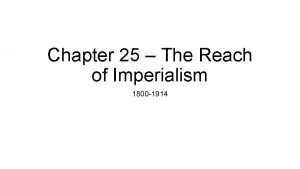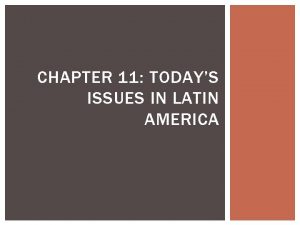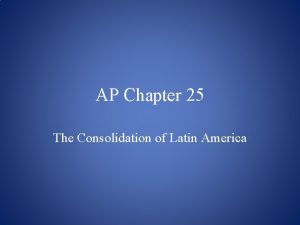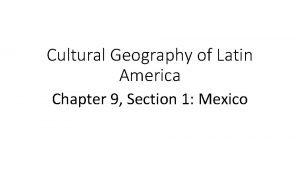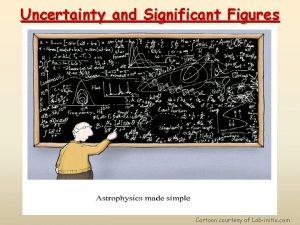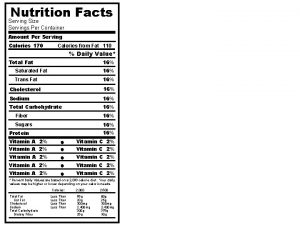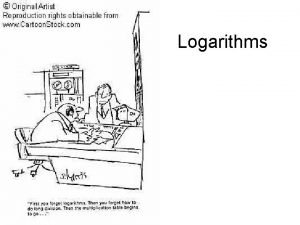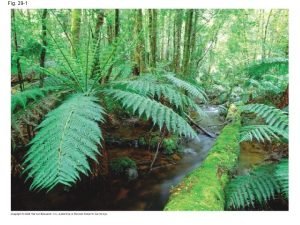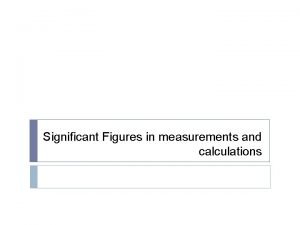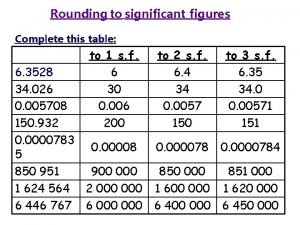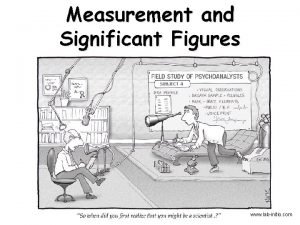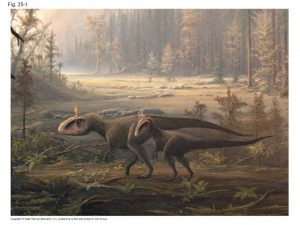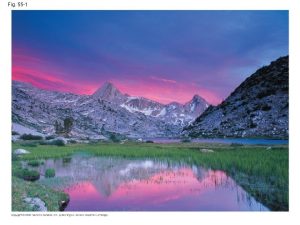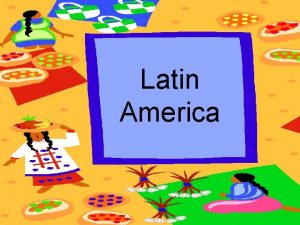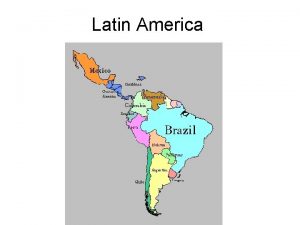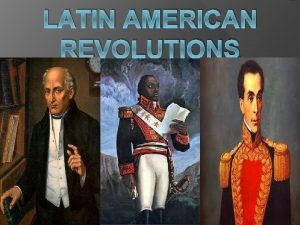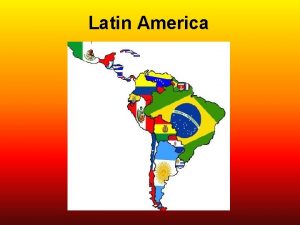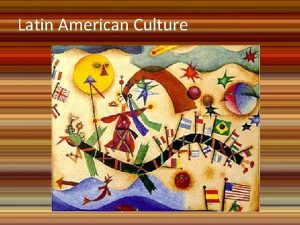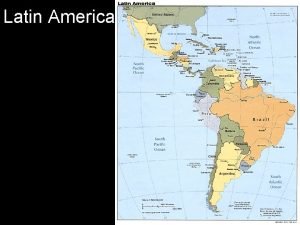Latin America Reference Chapter 4 Latin America Fig


































- Slides: 34

Latin America Reference Chapter 4: Latin America (Fig. 4. 1) Globalization & Diversity: Rowntree, Lewis, Price, Wyckoff

Introduction • Latin America has 17 countries – Colonized by Spain & Portugal (Iberian countries) – Large, diverse populations • 490 million people total • Indian and African presence • 75% of the people live in cities • Several megacities (more than 10 million people) – Industrialization & development grew since 1960 s • Free Trade Area of the Americas (FTAA) proposes to integrate economies of Latin America, North America and the Caribbean (except Cuba) • Natural resource extraction remains important Globalization & Diversity: Rowntree, Lewis, Price, Wyckoff 2

Environmental Geography: Neotropical Diversity • Much of the region lies in the tropics, but not all – Neotropics: tropical ecosystems of the Western Hemisphere » Large species diversity, inspired Darwin • Environmental Issues Facing Latin America • Relatively large land area and low population density has minimized environmental degradation • Latin America has the opportunity to avoid mistakes that other regions have made • Brazil and Costa Rica have conservation movements – The Destruction of Tropical Rainforests • Deforestation is the most common environmental problem in Latin America Globalization & Diversity: Rowntree, Lewis, Price, Wyckoff 3

Environmental Geography (cont. ) • Environmental Issues (cont. ) – Destruction of Tropical Rainforests (cont. ) – Affected regions: Atlantic coastal forests of Brazil and Pacific forests of Central America – Causes: agriculture, settlement, and ranching » Grassification: conversion of tropical forest to pasture – Concerns: loss of biological diversity » Tropical rainforests: 6% of Earth’s landmass but 50% of species – Urban Environmental Challenges: Valley of Mexico -Air pollution, smog -Water resources: quality & quantity -Sinking land: occurring as Mexico City draws down aquifer -Modern urban challenges: squatter settlements But Curitaba is a “Green City” Globalization & Diversity: Rowntree, Lewis, Price, Wyckoff 4

Environmental Issues in Latin America (Fig. 4. 3) Globalization & Diversity: Rowntree, Lewis, Price, Wyckoff

Environmental Geography (cont. ) • Western Mountains and Eastern Shields – The Andes • Relatively young, 5, 000 miles long; 30 peaks over 20 K feet • Contain valuable metals and minerals • Altiplano: treeless, elevated plain in Peru and Bolivia – The Uplands of Mexico and Central America • Most major cities and population found here • Rich volcanic soils Globalization & Diversity: Rowntree, Lewis, Price, Wyckoff 6

Physical Geography of Latin America (Fig. 4. 7) Globalization & Diversity: Rowntree, Lewis, Price, Wyckoff

Environmental Geography (cont. ) • River Basins and Lowlands – Amazon Basin • Largest river system in world by volume; second in length • Draws from nine countries – Plata Basin • Region’s second largest river watershed; economically productive • Climate • Little temperature variation in many areas • Larger regional variations in precipitation – El Nino • Warm Pacific current that usually arrives along coastal Ecuador and Peru in December – Regional weather upsets (drought, torrential rain, flooding) Globalization & Diversity: Rowntree, Lewis, Price, Wyckoff 8

Climate Map of Latin America (Fig. 4. 11) Globalization & Diversity: Rowntree, Lewis, Price, Wyckoff 9

Population and Settlement: The Dominance of Cities • Interior lowlands of South America sparsely populated • Higher population in Central America and Mexico interior plateaus • Dramatic population growth in 1960 s and ’ 70 s The Latin American City • Urbanization began in 1950 s; today 75% urbanized • Urban primacy: a country has a primate city if 3 to 4 times larger than any other city in the country – Urban form • Reflects colonial origins and contemporary growth • Latin American City Model San Jose, Costa Rica – Squatter settlements: makeshift housing on land not legally owned or rented by urban migrants, usually in unoccupied open spaces in or near a rapidly growing city Globalization & Diversity: Rowntree, Lewis, Price, Wyckoff 10

Population Map of Latin America (Fig. 4. 12) Globalization & Diversity: Rowntree, Lewis, Price, Wyckoff

Latin American City Model (Fig. 4. 13) Globalization & Diversity: Rowntree, Lewis, Price, Wyckoff

San Jose, Costa Rica Buenos Aires, Argentina Lima, Peru La Paz, Bolivia Globalization & Diversity: Rowntree, Lewis, Price, Wyckoff 13 Todos Santos, Baja, Mexico

Globalization & Diversity: Rowntree, Lewis, Price, Wyckoff 14

Population and Settlement (cont. ) • The Latin American City (cont. ) – Rural-to-Urban Migration • Since the 1950 s, peasants began to migrate to urban areas – Mechanization of agriculture, population pressure, consolidation of lands • Patterns of Rural Settlement • 130 million people (25%) live in rural areas – Rural Landholdings • Large estates used the best lands, relied on mixture of hired, tributary, and slave labor • Latifundia: Long-observed pattern of maintaining large estates • Minifundia: pattern associated with peasants farming small plots for their own subsistence • Agrarian reform: a popular but controversial strategy to redistribute land to peasant farmers – Mexico’s ejidos Globalization & Diversity: Rowntree, Lewis, Price, Wyckoff 15

Population and Settlement (cont. ) • Patterns of Rural Settlement (cont. ) – Agricultural Frontiers • Brazilian Amazon settlement is controversial • Provided peasants with land, tapped unused resources, shored up political boundaries • Population Growth and Movements • Rapid growth throughout most of the century followed by slower growth – Declining Total Fertility Rates (TFRs) since 1980 s – European Migration • Migration encouraged to till soils and “whiten” the mestizo population (of mixed European and Indian ancestry) – Many Europeans immigrated between 1870 s and 1930 s Globalization & Diversity: Rowntree, Lewis, Price, Wyckoff 16

Population and Settlement (cont. ) • Population Growth and Movements (cont. ) – Asian Migration • Many Chinese and Japanese between 1870 s and 1930 s – Former president of Peru a Japanese descendent • New wave of immigrants from South Korea – Latino Migration and Hemispheric Change • Economic opportunities spurred migrations within Latin America, or from Mexico to the U. S. • Political turmoil, civil wars caused migration Globalization & Diversity: Rowntree, Lewis, Price, Wyckoff 17

Principal Latin American Migration Flows (Fig. 4. 14) Globalization & Diversity: Rowntree, Lewis, Price, Wyckoff 18

Patterns of Cultural Coherence and Diversity: Repopulating a Continent • The Decline of Native Populations • There were many complex civilizations in Latin American before Europeans arrived – 1500: population of 47 million; 1650: 5 million – Causes: disease, warfare, forced labor, collapse of food production system – Indian Survival • Largest populations of Indians today: Mexico, Guatemala, Ecuador, Peru, and Bolivia • Indians trying to secure recognized territory in their countries – Comarca: loosely defined territory similar to a province or homeland, where Indians have political and resource control Globalization & Diversity: Rowntree, Lewis, Price, Wyckoff 19

Patterns of Cultural Coherence and Diversity (cont. ) • Patterns of Ethnicity and Culture • Racial caste system under Spanish: blanco (European), mestizo (mixed ancestry), indio (Indian), negro (African) – Languages • About 2/3 Spanish speakers, 1/3 Portuguese speakers • Indigenous languages in central Andes, Mexico, Guatemala – Blended Religions • 90% Roman Catholic – El Salvador, Uruguay have sizeable Protestant populations • Syncretic religions: blending of different beliefs – Allows animist practices to be included in Christian worship – Catholicism and African religions, with Brazil’s carnival as an example Globalization & Diversity: Rowntree, Lewis, Price, Wyckoff 20

Language Map of Latin America (Fig. 4. 19) Globalization & Diversity: Rowntree, Lewis, Price, Wyckoff

Geopolitical Framework: Redrawing the Map – Cycles of antagonism and cooperation • Organization of American States (OAS) • MERCOSUR (Southern Cone Common Market) • Iberian Conquest and Territorial Division • Treaty of Tordesillas divided South America between Spain and Portugal – Revolution and Independence • Elites born in the Americas led revolutions, resulting in the creation of new countries – Persistent Border Conflicts • Colonial boundary lines were not well accepted • When states gained independence, border issues grew Globalization & Diversity: Rowntree, Lewis, Price, Wyckoff 22

Shifting Political Boundaries (Fig. 4. 21) Globalization & Diversity: Rowntree, Lewis, Price, Wyckoff 23

Geopolitical Framework (cont. ) • Iberian Conquest and Territorial Division (cont. ) – The Trend Toward Democracy • Long independence, but political stability has been a problem • Democratic elections since 1980 s • Most of the countries are free-market democracies Simon Bolivar Globalization & Diversity: Rowntree, Lewis, Price, Wyckoff 24

Geopolitical Framework (cont. ) • Regional Organizations (cont. ) – Trade Blocks • To foster internal markets and reduce trade barriers – Latin American Free Trade Association (LAFTA), Central American Common Market (CACM), Andean Group, NAFTA, Mercosur – Insurgencies and Drug Traffickers • Guerrilla groups have controlled large portions of their countries through violence and intimidation – FARC (Revolutionary Armed Forces of Colombia); ELN (National Liberation Army) – Colombia has highest murder rate in the world • Drug cartels: powerful and wealthy organized crime syndicates Globalization & Diversity: Rowntree, Lewis, Price, Wyckoff 25

Economic and Social Development: Dependent Economic Growth • Most Latin American countries are “middle income” – Extreme poverty in the region, however • Development Strategies • Import substitution: policies that foster domestic industry by imposing inflated tariffs on all imported goods – Industrialization • Manufacturing emphasized since 1960 s – Growth poles: planned industrial centers – Maquiladoras and Foreign Investment • Maquiladoras: Mexican assembly plants lining U. S. border • Other Latin American countries attracting foreign companies – The Informal Sector • Provision of goods & services without government regulation • Self-employment: construction, manufacturing, vending, etc. Globalization & Diversity: Rowntree, Lewis, Price, Wyckoff 26

Economic and Social Development (cont. ) • Primary Exports • Latin America specialized in commodities into the 1950 s – Bananas, coffee, cacao, grains, tin, rubber, petroleum, etc. – Agricultural Production • Since 1960 s, agriculture has become more diversified and mechanized • Machinery, hybrid crops, chemical fertilizers, pesticides, make agriculture very productive – Mining and Forestry • • Products: silver, zinc, copper, iron ore, bauxite, gold, oil, gas Mexico, Venezuela, Ecuador export oil Mining becoming mechanized, laying off workers Logging – Exportation of wood pulp provide short-term cash infusion – Plantation forests of introduced species replace diverse native forests Globalization & Diversity: Rowntree, Lewis, Price, Wyckoff 27

Economic and Social Development (cont. ) • Latin America in the Global Economy • Dependency theory – Dependency theory holds that expansion of European capitalism created Latin American condition of underdevelopment » Creates prosperous cores and dependent, poor peripheries – Increased economic integration within Latin America and dominance of U. S. market – Neoliberalism as Globalization • Neoliberal policies: stress privatization, export production, and few restrictions on imports – Benefits include increased trade and more favorable terms for debt repayment; most political leaders are embracing it » Some signs of discontent with neoliberalism and support for reduction of poverty and inequality Globalization & Diversity: Rowntree, Lewis, Price, Wyckoff 28

Economic and Social Development (cont. ) • Latin America in the Global Economy (cont. ) – Dollarization • Dollarization: process in which a country adopts (in whole or in part) the U. S. dollar as its official currency – Full dollarization – U. S. dollar becomes only currency » Until 2000, Panama was the only fully dollarized Latin American country » Ecuador also became fully dollarized in 2000 » El Salvador considering – Limited dollarization more common strategy » U. S. dollars circulate with country’s national currency • Tends to reduce inflation, eliminate fears of currency devaluation, and reduce costs of trade Globalization & Diversity: Rowntree, Lewis, Price, Wyckoff 29

Economic and Social Development (cont. ) • Social Development • Marked improvements since 1960 – Declining child mortality rate, along with higher rates for life expectancy and educational attainment » Most countries had cuts of 50% or more in child mortality – Important role for non-government organizations (NGOs) » Humanitarian organizations, churches, community activists – Still, regional social differences within countries – Race and Inequality • Relative tolerance, but Amerindians and blacks overrepresented among the poor – Hard to ignore ethnicity and race when explaining contrasts in income and availability of services Globalization & Diversity: Rowntree, Lewis, Price, Wyckoff 30

Race and Ethnicity in Latin America Globalization & Diversity: Rowntree, Lewis, Price, Wyckoff Africans 31

Mapping Poverty and Prosperity (Fig. 4. 29) Globalization & Diversity: Rowntree, Lewis, Price, Wyckoff

Economic and Social Development (cont. ) • Social Development (cont. ) – The Status of Women • Many women work outside of the home (30%-40%) – Lower than rate in U. S. but comparable to many European countries • Legally, women can vote, own property, and sign for loans, but less likely than men to do so – Reflective of patriarchal tendencies • Low illiteracy rates – Highest rates in Central America • Trend toward smaller families – Related to education and workforce participation Globalization & Diversity: Rowntree, Lewis, Price, Wyckoff 33

Conclusion • Latin America is the first region fully colonized by Europe • Demographic recovery slow after early population decline • Latin America is rich in natural resources • But will resources be exploited for short-term gain or sustainability? • Active informal economy, rapid development End of Chapter 4: Latin America Globalization & Diversity: Rowntree, Lewis, Price, Wyckoff
 Fig. 2
Fig. 2 Why called latin america
Why called latin america The bell jar chapter 7
The bell jar chapter 7 Reference node and non reference node
Reference node and non reference node Reference node and non reference node
Reference node and non reference node Chapter 25 lesson 1 colonial rule in southeast asia
Chapter 25 lesson 1 colonial rule in southeast asia Chapter 11 today's issues in latin america
Chapter 11 today's issues in latin america Chapter 25 the consolidation of latin america
Chapter 25 the consolidation of latin america Vocabulary activity 9 cultural geography of latin america
Vocabulary activity 9 cultural geography of latin america Chapter 8: the physical geography of latin america answers
Chapter 8: the physical geography of latin america answers Sig figs
Sig figs The composite bar is firmly attached to unyielding supports
The composite bar is firmly attached to unyielding supports Three significant figures
Three significant figures Significant figures rules
Significant figures rules Addition rule of significant figures
Addition rule of significant figures Sig figs for logs
Sig figs for logs Ph sig fig rules
Ph sig fig rules Sig fig rules
Sig fig rules Logarithms in chemistry
Logarithms in chemistry Nernst equation simplified
Nernst equation simplified Chips ahoy nutrition facts
Chips ahoy nutrition facts Log sig fig
Log sig fig Archegonium
Archegonium Jesus cursed the fig tree kjv
Jesus cursed the fig tree kjv No man eat fruit of the hereafter forever
No man eat fruit of the hereafter forever Parable of the barren fig tree
Parable of the barren fig tree Significant figure game
Significant figure game Sig figs in 150
Sig figs in 150 Significant numbers
Significant numbers Sig fig
Sig fig Sig fig checker
Sig fig checker Fig organisasi
Fig organisasi Canyon tree frog
Canyon tree frog Population vs community ecology
Population vs community ecology Bioflix activity: gas exchange -- inhaling and exhaling
Bioflix activity: gas exchange -- inhaling and exhaling





